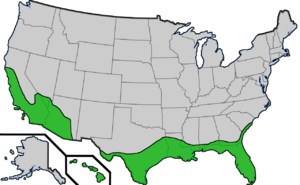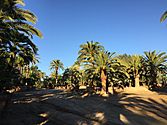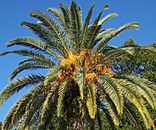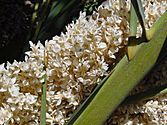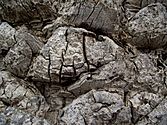Canary Island date palm facts for kids
Quick facts for kids Canary Island date palm |
|
|---|---|
 |
|
| Conservation status | |
| Scientific classification | |
| Genus: |
Phoenix
|
| Species: |
canariensis
|
The Phoenix canariensis, also known as the Canary Island date palm or pineapple palm, is a type of flowering plant in the palm family called Arecaceae. It originally comes from the Canary Islands, which are islands off the coast of Morocco. This palm is a close relative of the Phoenix dactylifera, which is the palm that produces the dates we usually eat.
The Canary Island date palm is a special symbol of the Canary Islands, just like the canary Serinus canaria. These palms are often used to make gardens and public spaces look beautiful. People sometimes move very old palms to new places. A Canary Island date palm with a 10 m (30 ft) tall trunk is usually around 60 years old!
Contents
What Does the Canary Island Date Palm Look Like?
The Canary Island date palm is a big, single palm tree. It can grow 10–20 m (33–66 ft) tall, and sometimes even up to 40 m (131 ft). Its leaves are very long, about 4–6 m (13–20 ft) in length. Each palm usually has about 75 to 125 leaves.
Each leaf has many smaller leaflets, usually 80 to 100 on each side of the main stem. The fruit of this palm is an oval-shaped, yellow to orange fruit called a drupe. It's about 2 cm (0.79 in) long and 1 cm (0.39 in) wide. Inside, there's one large seed. You can eat the fruit, but it's not as tasty as the dates from the true date palm.
Different Names for the Palm
In English, this palm is commonly called the Canary Island date palm or pineapple palm. In Spanish-speaking countries and in the Canary Islands, its common name is palmera canaria.
Growing Canary Island Date Palms
People often grow the Canary Island date palm in places with wet winters, like a Mediterranean climate. They also grow well in places with wet summers, such as eastern Australia and the southeastern United States. You can even find them growing in cooler, oceanic climates like Ireland and the UK.
These palms can grow where temperatures rarely drop below −10 or −12 °C (14 or 10 °F) for long periods. However, they might need some protection if it gets colder than usual. This tree grows slowly and can only be grown from seeds.
You can easily spot a Canary Island date palm by looking at its crown of leaves and its trunk. Gardeners often trim and prune these palms to make them look nicer. When the lower leaves are trimmed, the base of the crown can look like a pineapple!
Canary Island date palms can get a fungal disease called Fusarium wilt. This disease often spreads through bad seeds, soil, or dirty pruning tools. To help stop the disease from spreading, tools should be cleaned before using them on these palms. A bug called the South American palm weevil can also harm these trees, making their leaves droop, turn brown, and eventually causing the tree to die.
This palm has won the Royal Horticultural Society's Award of Garden Merit for being an excellent garden plant.
Using Palms in Landscaping
The Canary Island date palm is used in many famous landscaping projects, especially in California, USA. There's a story that the first Canary Island date palm in what is now San Diego was planted in 1769 by a Spanish missionary named Junípero Serra. While this specific story might not be true, Spanish missionaries did plant true date palms in California in the late 1700s for their fruit. Still, a famous Canary Island date palm was known as "The Serra Palm" before it died in 1957.
Other well-known places in California that use these palms include Stanford University. Its campus has about 600 Canary Island date palms. The main entrance, Palm Drive, has 166 of these palms lining the road. Oracle Park in San Francisco, which is the baseball stadium for the San Francisco Giants, also has many Canary Island date palms at its entrance and near the outfield.
Other Ways People Use This Palm
In the Canary Islands, people use the sap from this date palm to make a sweet product called palm syrup. The island of La Gomera is the only place in the Canary Islands where this special syrup is made.
Where It Grows Wild (Invasiveness)
In some places, the Phoenix canariensis has become an invasive plant. This means it has spread and now grows wild in areas where it didn't originally come from. For example, in Bermuda and parts of the United States (like Florida and California), it is considered naturalized. It has also spread in some areas of Spain, Portugal, Italy, Australia, and New Zealand. In Auckland, New Zealand, this palm has even become a host for another naturalized plant, the Australian strangler fig.
Gallery
See also
- List of animal and plant symbols of the Canary Islands
- In Spanish: Palma fénix para niños



